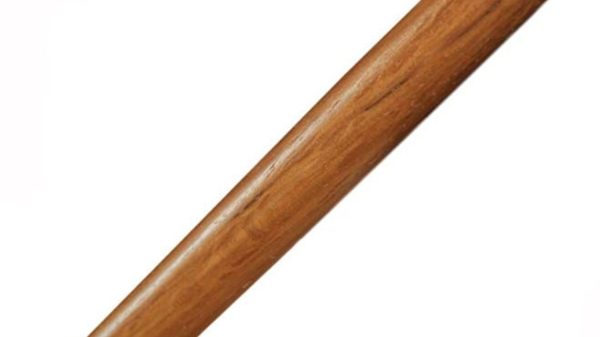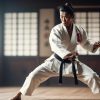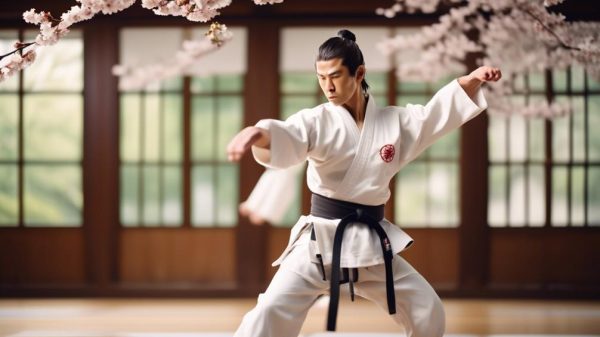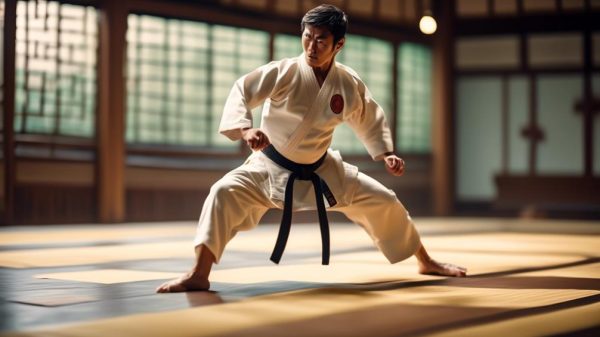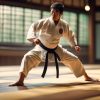Kata are defensive and offensive technique combinations performed solo in set sequences, like martial arts dances. But does practicing kata help real fighting skills?
Some believe these choreographed routines create bad habits unable to handle real exchanges against opponents who punch, kick and grapple back fiercely. Uselessness claims arise.
However, many argue kata remains very useful for ingraining posture, distancing, blocks, strikes and transitions into instinctive reactions without needing thought thanks to drill refinement repetition.
This article examines viewpoints arguing kata’s irrelevance versus worth for building reflexive self-defense technique capabilities and maintaining cultural traditions of sharing knowledge through cooperative rehearsal.
The Historical Significance of Kata
The historical significance of kata is deeply intertwined with the martial traditions of Asia, serving as a crucial training method and a cultural touchstone that encapsulates the philosophy and fighting wisdom of ancient warriors.
Kata forms the backbone of karate and other Japanese martial arts, honing techniques and instilling a sense of rhythm and balance in martial arts students.
Critics may view kata as an archaic practice limited by its choreographed nature.
While it’s true that kata doesn’t mimic the unpredictable chaos of a real fight, dismissing its relevance ignores its historical significance and the layers of strategic depth embedded within each movement.
Kata isn’t about fighting an imaginary opponent; it’s about mastering the self.
In Shotokan Karate, katas are considered a living encyclopedia of self-defense moves, each with practical applications that extend beyond the dojo.
Younger color belts may appreciate the clarity kata brings to learning basic techniques, while advanced practitioners see beyond the surface, extrapolating the nuances of each form to refine their understanding of combat principles.
Kata, therefore, isn’t just practice—it’s a dialogue with history, inviting continuous innovation and critical examination.
Arguments Supporting Kata’s Usefulness
Understanding the historical roots of kata paves the way for appreciating its practical benefits in modern martial arts training.
You’re not just going through motions; you’re engaging in a time-tested method to hone your skills.
Let’s break down the core advantages:
- Development of Muscle Memory: Through repetitive practice, kata ingrains defensive and offensive techniques into your muscle memory. This ensures that in a real confrontation, your body reacts almost instinctively.
- Physical Enhancement: Kata routines improve a student’s physical prowess, from balance to coordination. It’s not just about mimicking an attack on an imaginary opponent’s neck; it’s about mastering your body’s movements.
- Mental Conditioning: As you practice certain moves, you’re also sharpening your focus and mental resilience. Kata is a mental drill as much as it’s a physical one.
- Standardization for Progression: Karate schools use slightly different kata formats, and these serve as benchmarks during belt tests, providing a clear structure for assessing proficiency.
You see, kata isn’t just a set of movements; it’s a comprehensive tool. It’s about pushing the limits of what your body and mind can do – and that’s no small feat.
Remember, mastery isn’t just about learning new tricks; it’s about perfecting the old ones too.
Counterpoints: The Case Against Kata
While kata provides a structured approach to martial arts, critics argue that it fails to adequately prepare practitioners for the spontaneity of real combat.
Striving for mastery requires recognizing that practicing specific moves against imaginary opponents does not translate to the unpredictability faced in live confrontations.
The precision of kata movements is undeniable, but how does that meticulous choreography hold up when facing an unscripted and relentless assailant charging at you?
Let’s analyze this pragmatically and examine the pros and cons, using Shotokan Katas—one of the prominent Karate styles—as an example:
| Aspect | Pro-Kata Argument | Con-Kata Argument |
|---|---|---|
| Real Combat Prep | Builds muscle memory and precision. | Lacks live, unpredictable sparring. |
| Techniques Taught | Teaches intricate kicking techniques. | Imaginary foes don’t mimic real attackers. |
| Defensive Skills | Instills defensive techniques. | Unable to adjust to unscripted attacks. |
| Physical Fitness | Excellent for physical conditioning. | May not be functional in a real fight. |
Innovative training methods that avoid the rigidity of kata are gaining traction.
To truly master the art of combat, one must transition from rehearsed to reactive, from kata’s polished dance to the gritty, adaptive skills essential for real-world self-defense.
Kata in Modern Combat Training
The role of kata in modern combat training remains significant despite debates about its applicability in unpredictable combat situations.
It’s a fundamental tool for teaching essential techniques and fostering mental discipline.
Although the practicality of kata may be questioned, it serves as more than a mere routine; it’s a strategic instrument for improving combat skills.
- Repetitive Practice for Muscle Memory: Kata allows practitioners to repetitively practice specific moves, which aids in developing muscle memory for both offensive and defensive techniques.
- Physical Conditioning and Solo Drills: It serves as a method to enhance a student’s physical conditioning, akin to a solo drill where striking and kicking the air can be as physically demanding as hitting a heavy bag.
- Visualization and Reaction Times: Engaging in kata involves mentally simulating combat scenarios, sharpening the practitioner’s ability to visualize situations and improve reaction times.
- Bridging Learning and Application: Kata acts as a bridge between learning techniques in the absence of an opponent and applying them in sparring or real-world situations.
It is essential not to hastily dismiss the value of kata in modern combat training.
It goes beyond the physical movements; it cultivates a mindset of precision and awareness critical to mastery in martial arts.
While it may not directly simulate the chaos of a street fight, it lays the groundwork for martial arts proficiency.
Balancing Tradition With Practicality
Balancing the revered traditions of kata with the demands of practical combat skills challenges martial artists to adapt time-honored practices to the realities of modern fighting.
As you dive into this debate, consider that kata isn’t just about rehearsing patterns; it’s a method to practice certain moves, perfect defensive techniques, and hone offensive strategies against imaginary opponents.
It’s a form of physical conditioning that both preserves tradition and has the potential to contribute to practicality.
However, don’t let your pursuit of mastering kata blind you to its limitations. Critics rightly point out that kata doesn’t fully equip you for the chaos of real-life combat.
Sparring and partner training inject the unpredictability you’ll face outside the dojo, and integrating these with kata practice is essential.
To answer the question ‘Is Kata Useful?’ you must be critical and innovative. Use kata as a foundational tool, but don’t stop there.
Expand your repertoire to include dynamic and reactive drills that mimic actual confrontations.
Mastery demands that you balance the beauty of tradition with the necessity of practicality.
Is Kata Actually Useful?
The practice of kata has historical roots and offers numerous mental and physical benefits.
Despite facing criticism, it effectively combines traditional and contemporary elements, promoting enhanced breathing control and cultural significance.
Why Is Kata so Important?
Kata holds immense importance in martial arts as it embodies cultural significance and philosophical aspects.
It helps in developing mental discipline, breath control, and precision through traditional methods, leading to enhanced self-awareness with its rhythmic and flowing movements.
It goes beyond mere practice; it serves as a blueprint for perfection.
How Is Kata Used in Real Life?
In practical settings, kata is utilized for enhancing mental discipline, achieving a state of flow, and increasing self-awareness.
It involves precise training, memorization of movements, and control of breathing.
This practice is deeply rooted in cultural tradition and holds great significance for reducing stress.
Can Kata Build Muscle?
Yes, practicing kata can help in building muscle by focusing on precise movements, improving balance, and incorporating rhythmic exercises.
It is a form of solo workout that enhances endurance, increases flexibility, and improves mental concentration through its traditional sequences and controlled breathing techniques.

